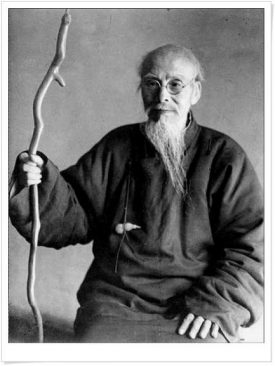斉白石(さいはくせき)
| 作家名 | 斉白石 |
|---|---|
| ふりがな | さいはくせき |
| 生没年 | 1864(同治2年) – 1957(中華人民共和国) |
斉白石

画家・書家・篆刻家
1864年~1957年
1864年~1957年
中国清朝末期から現代の詩人・画家 ・篆刻家。現代中国画の巨匠。草花・虫・蝦などを緻密かつ大胆に描き、 独自の画風で世界的に評価を得る。湖南省湘潭県杏子塢星斗塘出身、斉白石は貧農の家に生まれ、7歳で数カ月間、私塾に通い初等教育を受けたが身体も弱かったこともあり家計の困窮と病弱により学校には1年に満たない期間しか通えなかった。幼少時より絵を書くことを好んだ。農作業を手伝うのにも必要な体力に欠けていたが、14歳で指物師として働き始める。木工としての腕は極めて優れ、やがて広い地域で評判となる。 木工の傍ら表具師出身の蕭薌陔(伝鑫)について肖像画を習い後に美人画も描いた。独学で絵を描き始め、27歳で湖沁園の弟子となり、花鳥画、山水画等の画法の勉強を始め、同時期に、また詩文を陳少潘、山水画を地元画家の譚溥に学んでいる。30歳になると同郷の詩友と「龍山詩社」・「羅山詩社」を結び、合わせて書法や篆刻も独学し、文人的な資質を培った。篆刻は大工だったこともあり鑿を使うように大胆に鉄筆を揮るい、拙劣な枯れた作風とされた。後に鄧散木が白石の印法を敬慕している。40歳頃から全国を5回にわたり、旅してあらゆる景観を銘記し、同時に全土の優れた伝統芸術を実見して芸術家としての視野を広げた。特に八大山人、石濤、徐渭、呉昌碩といった先人に強い影響を受け、 斉白石独特の画風をより一層深めた。その後10年を「家居十年」と呼び、故郷にじっくり腰を据え読書に耽り、詩書画印の製作に没頭した。「借山図巻」・「石門二十四景」などの大作もこの頃の作品である。故郷での争乱事件を避け、55歳で北京に居宅を定め、売画・売印で生計を立て始めた。当時の北京は臨模や倣古を重んじ文人的素養を第一とするような保守的な風潮が色濃く、農民出身で木工だった白石は白眼視され、ときに迫害された。このような辛い状況にあって高名な画家陳師曽は白石の才能を見出し芸術的な交流を深めるとともに様々な形で白石を支援した。題材は海老、蟹、鶏、蛙などのいきものをシンプルに描くことを好み自宅にそれらの生きて動く様を描写する為に飼っていた。また、草花、花鳥、昆虫、山水などを組み合わせ、濃い色彩と自由闊達な水墨を用いて生き生きと描いた。1922年、東京で開催された日中共同絵画展に白石の作品を出典したのも陳師曽だったが、これをきっかけに白石の国際的な評価が高まり日本でも知られるようになる。1930年(66歳)にはイサム・ノグチが北京に来て画法を学びに来ている。 陳半丁・陳師曽・凌文淵と共に、斉白石は京師四大画家と称された。白石は晩年になって、徐渭(じょい)の奔放な溌墨、石濤(せきとう)や八大山人のシンプルで深淵な筆さばき、呉昌碩(ごしょうせき)の書法などを吸収して、いわゆる「紅花墨葉」の画風を確立した。白石は、倣古主義に陥り停滞した近代中国芸術の旧習を打破し、新風を吹き込み、現代中国画の巨匠と評価されるにいたった。伝統的な文人・士大夫の芸術に根ざしながらも木工・画工のときから培われた民間芸術の伝統が結ばれ、換骨奪胎を繰り返しながら、清新雄健・質朴秀麗な独自の画風を生み出した。北京美術専門学校教授、中国美術家協会主席を歴任し、政府より 人民芸術家の称号を与えられ、56年に国際平和賞を受賞、 90歳を過ぎても1年で600点の作品を描いた事でも知られる。享年95歳。
Qi Baishi (齊白石, 1864-1957) was one of the most well-known contemporary Chinese painters. His original name is Qi Huang (齊璜) and style name Weiqing (渭清). Baishi (“white stone”) is one of his pseudonyms. Some of Qi’s major influences include the Ming Dynasty artist Xu Wei (徐渭) and the early Qing Dynasty painter Zhu Da (朱耷, 即”八大山人”). The subjects of his paintings include almost everything, commonly animals, scenery, figures, vegetables, and so on. In his later years, many of his works depict mice, shrimps, or birds. Qi Baishi is particularly known for painting shrimps.Born to a peasant from Xiangtan (湘潭), Hunan, Qi became a carpenter at fourteen, and it was largely through his own efforts that he became adept at the arts of poetry, calligraphy, painting, and seal-carving. In his forties, Qi Baishi began traveling and looking for more inspiration. He came upon the Shanghai School, which was very popular at the time, and met Wu Changshuo (吳昌碩) who then became another mentor to him and inspired a lot of his works. Another influence of Qi Baishi came about fifteen years later, as Qi became close to Chen Shizeng (陳師曾) after he settled down in Beijing.
Qi Baishi theorized that “paintings must be something between likeness and unlikeness.” His prodigious output reflects a diversity of interests and experience, generally focusing on the smaller things of the world rather than the large landscape.Shrimp, fish, crabs, frogs, insects, and peaches were his favorite subjects. Using heavy ink, bright colors, and vigorous strokes, he created works of a fresh and lively manner that expressed his love of nature and life.
In 1953 Qi Baishi was elected to the president of the Association of Chinese Artists. He was active to the end of his long life and served briefly as the honorary president of the Beijing Academy of Chinese Painting, which was founded in May, 1957. He died in Beijing on September 16, 1957.
